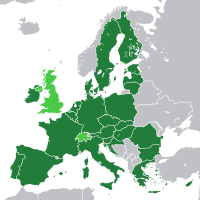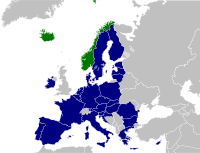Joint Research Centre

| This article is part of a series on |
 |
|---|
|
|
The Joint Research Centre (JRC) is the
Leadership
The JRC is a
Structure
Composed of strategy and coordination, knowledge production, knowledge management and support directorates, the JRC is spread across six sites in five EU countries: in Belgium (Brussels and Geel), Germany (Karlsruhe, Institute for Transuranium Elements), Italy (Ispra), the Netherlands (Petten), and Spain (Seville). Their responsibilities are:
- to create, manage and make sense of knowledge to support European policies with independent evidence
- to develop innovative tools and make them available to policymakers
- to anticipate emerging issues that need to be addressed at EU level and understand policy environments
- to share know-how with EU countries, the scientific community and international partners
- to contribute to the overall objective of Horizon 2020
- to conduct Euratom-funded research on nuclear safety and security to contribute to the transition to a carbon-free economy.[1]
A portion of the budget of the EU under the Framework Programme is allocated directly to the JRC.[3]
History
The Italian Centre in Ispra originally belonged to the Comitato Nazionale per l'Energia Nucleare (CNEN) and was officially transferred to the Community on 1 March 1961.[4] Since 1973, non-nuclear research evolved rapidly, especially in topics related to safety and the environment. After 16 years of research, the nuclear reactor at JRC Ispra[5] was shut down in 1983.[6]
At the beginning of the 1980s, a re-examination of the mandate and evaluation of the activities of the JRC began. Future activities were to continue to support the commission's implementations of Community policies. In 1987, journalist Richard L. Hudson published an article on the home page on The Wall Street Journal, which featured the opinions of a remote sensing expert employed at JRC, along with some insights drawn from an external report commissioned by the Directorate-General. These opinions where combined to express deep concern about the center's state at the time, describing it as a disaster hindered by dysfunctional bureaucratic constraints. The then JRC director of projects, Raymond Klersy, criticized the article, claiming they were biased and incomplete in their representation of the situation.[7]
In 1992, the results of a study led to a proposal to convert the JRC Ispra site into an environmentally-optimised model site; the "ECO Centre". The JRC employs around 2787 staff with an annual budget of 372,5 million euros for 2017.[8]
Science areas
The JRC research activities are clustered into ten science areas:
- Agriculture and food security
- Economic and Monetary Union
- Energy and transport
- Environment and climate change
- Health and consumer protection
- Information Society
- Innovation and growth
- Nuclear safety and security
- Safety and Security
- Standards[9]
See also
- European Commissioner for Innovation, Research, Culture, Education and Youth
- Best Available Techniques Reference Document (BREF)
- Directorate-General for Research
- Directorate-General for Information Society and Media (European Commission)
- European Research Area (ERA)
- European Research Council (ERC)
- European Institute of Technology(EIT)
- European Research Advisory Board (EURAB)
- European School
- Framework Programmes for Research and Technological Development
- Joint Technology Initiative
- Lisbon Strategy
- Seventh Framework Programme
- Scientific Advice Mechanism
- Sixth Framework Programme
References
- ^ a b "Joint Research Centre's website".
- ^ Organisation – Joint Research Centre. Retrieved on 2020-05-13
- ^ "The Joint Research Centre". STI Review Special Issue on Public/Private Partnerships in Science and Technology. OECD. 1998. p. 258.
- ^ History of the Joint Research Centre, Ispra Site. YouTube (21 December 2009). Retrieved on 2013-09-05.
- ^ Essai Orgel (ESSOR), 1969. YouTube (30 July 2012). Retrieved on 2013-09-05.
- ^ "Archived copy" (PDF). Archived from the original (PDF) on 14 January 2012. Retrieved 14 August 2013.
{{cite web}}: CS1 maint: archived copy as title (link) - ^ Migliorino, Gianni (22 August 1987). "il centro di ispra? un vero disastro scientifico". Corriere della Sera (in Italian).
- ^ "JRC Annual Report 2017 – European Commission". European Commission. Retrieved 26 October 2018.
- ^ team, FPFIS (22 November 2012). "Science areas". EU Science Hub – European Commission. Retrieved 15 January 2021.
 Text was copied from this source, which is available under a Creative Commons Attribution 4.0 International License.
Text was copied from this source, which is available under a Creative Commons Attribution 4.0 International License.





